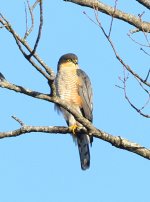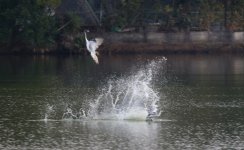We have always had Sparrowhawks in the winter at my local spot in Nara, but they were usually flying fairly high so it's been difficult to get details. But in the last year or two, they appear to have been breeding nearby and have become more confident and pose well in convenient trees.
(The first five photos are from this month; the last two from February 2020 (this bird is around now, but these were the best photos I have).
Question One:
These four photos show three birds which are often around together (sometimes all three can be seen on different trees at the same time), and seem to be a family. The first is obviously a male. I'm fairly sure that the second is female. I think the third bird (photos from front and back) is a juvenile - looking at books, the thicker chest barring compared with two seems to indicate juvenile. Am I right? And if so, are the white spots on the back of the bird in photo four a good juvenile marker? And is it possible to sex juvenile birds?




Question Two:
The male in photo one above has a large white bar across the back of its head. The juvenile has an incipient one. Some of my friends seem to think this is significant at a sub-species level, but I don't. 'Raptors of the World' seems to show it in male and female birds (but other books I have don't). Is it a normal feature of Sparrowhawks?

Question Three (the interesting one, I think, or hope):
For the last four years an exceptionally red male has been wintering here - it'a not an unworn version of the male above - they are obviously different and are sometimes seen on the same day. One of my Japanese books mentions a darker red form and says it is a 'continental visitor'. But there is no ssp given, and the continent is Eurasia, so in theory it could have come from anywhere between Shanghai and Calais. 'Raptors of the World' mentions and illustrates a slightly darker (than nominate) bird ssp melaschistos (though the darkness seems to relate more to the back of the bird) which it specifies as 'Himalayas / Western China' (i.e. not directly adjacent to Japan). Does anybody looking have any comments on this bird?


Thanks for looking.
(The first five photos are from this month; the last two from February 2020 (this bird is around now, but these were the best photos I have).
Question One:
These four photos show three birds which are often around together (sometimes all three can be seen on different trees at the same time), and seem to be a family. The first is obviously a male. I'm fairly sure that the second is female. I think the third bird (photos from front and back) is a juvenile - looking at books, the thicker chest barring compared with two seems to indicate juvenile. Am I right? And if so, are the white spots on the back of the bird in photo four a good juvenile marker? And is it possible to sex juvenile birds?




Question Two:
The male in photo one above has a large white bar across the back of its head. The juvenile has an incipient one. Some of my friends seem to think this is significant at a sub-species level, but I don't. 'Raptors of the World' seems to show it in male and female birds (but other books I have don't). Is it a normal feature of Sparrowhawks?

Question Three (the interesting one, I think, or hope):
For the last four years an exceptionally red male has been wintering here - it'a not an unworn version of the male above - they are obviously different and are sometimes seen on the same day. One of my Japanese books mentions a darker red form and says it is a 'continental visitor'. But there is no ssp given, and the continent is Eurasia, so in theory it could have come from anywhere between Shanghai and Calais. 'Raptors of the World' mentions and illustrates a slightly darker (than nominate) bird ssp melaschistos (though the darkness seems to relate more to the back of the bird) which it specifies as 'Himalayas / Western China' (i.e. not directly adjacent to Japan). Does anybody looking have any comments on this bird?


Thanks for looking.











